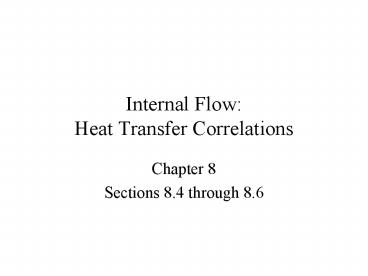Internal Flow: Heat Transfer Correlations - PowerPoint PPT Presentation
1 / 18
Title:
Internal Flow: Heat Transfer Correlations
Description:
Chapter 8. Sections 8.4 through 8.6. For a smooth surface and fully turbulent conditions , the ... Turbulent Flow in a Circular Tube: ... – PowerPoint PPT presentation
Number of Views:364
Avg rating:3.0/5.0
Title: Internal Flow: Heat Transfer Correlations
1
Internal FlowHeat Transfer Correlations
- Chapter 8
- Sections 8.4 through 8.6
2
Fully Developed Flow
Fully Developed Flow
- Laminar Flow in a Circular Tube
The local Nusselt number is a constant
throughout the fully developed region, but its
value depends on the surface thermal condition.
- Turbulent Flow in a Circular Tube
3
Fully Developed (cont.)
Smooth surface
- Noncircular Tubes
- Use of hydraulic diameter as characteristic
length
- Since the local convection coefficient varies
around the periphery of a tube, - approaching zero at its corners, correlations
for the fully developed region - are associated with convection coefficients
averaged over the periphery - of the tube.
- Laminar Flow
4
(No Transcript)
5
Entry Region
Effect of the Entry Region
- The manner in which the Nusselt decays from
inlet to fully developed conditions - for laminar flow depends on the nature of
thermal and velocity boundary layer - development in the entry region, as well as
the surface thermal condition.
Laminar flow in a circular tube.
- Combined Entry Length
Thermal and velocity boundary layers develop
concurrently from uniform profiles at the inlet.
6
Entry Region (cont)
- Thermal Entry Length
Velocity profile is fully developed at the inlet,
and boundary layer development in the entry
region is restricted to thermal effects.
Why?
- Average Nusselt Number for Laminar Flow in a
Circular Tube with Uniform - Surface Temperature Properties should be
evaluated at
except ms
- Combined Entry Length
and
Hausen
- Constant surface temperature Thermal Entry
Length or combined length Pr5
Sieder Tate
7
Entry Region (cont)
- Average Nusselt Number for Turbulent Flow in a
Circular Tube
- Effects of entry and surface thermal conditions
are less pronounced for - turbulent flow and can be neglected.
Function of inlet shape, Pr, Re. Properties
should be evaluated at
- For liquid metals, use equations 8.62, or 8.63
8
Entry Region (cont)
- Noncircular Tubes
- Laminar Flow
9
Annulus
The Concentric Tube Annulus
- Fluid flow through
- region formed by
- concentric tubes.
- Convection heat transfer
- may be from or to inner
- surface of outer tube and
- outer surface of inner tube.
- Convection coefficients are associated with
each surface, where
10
Annulus (cont)
- Fully Developed Laminar Flow
Nusselt numbers depend on and surface
thermal conditions (Tables 8.2, 8.3)
- Fully Developed Turbulent Flow
Correlations for a circular tube may be used with
replaced by , using the Dittus-Boelter
equation
11
Problem Gas Turbine Vane
Problem 8.43 For an air passage used to cool a
gas turbine vane, calculate the air outlet
temperature and heat removed from the vane.
12
Problem Gas Turbine Vane (cont)
13
Problem Gas Turbine Vane (cont)
14
Problem Oven Exhaust Gases
Problem 8.52 Determine effect of ambient air
temperature and wind velocity on temperature at
which oven gases are discharged from a stack.
15
Problem Oven Exhaust Gases (cont)
16
Problem Oven Exhaust Gases (cont)
17
Problem Oven Exhaust Gases (cont)
18
Problem Oven Exhaust Gases (cont)































